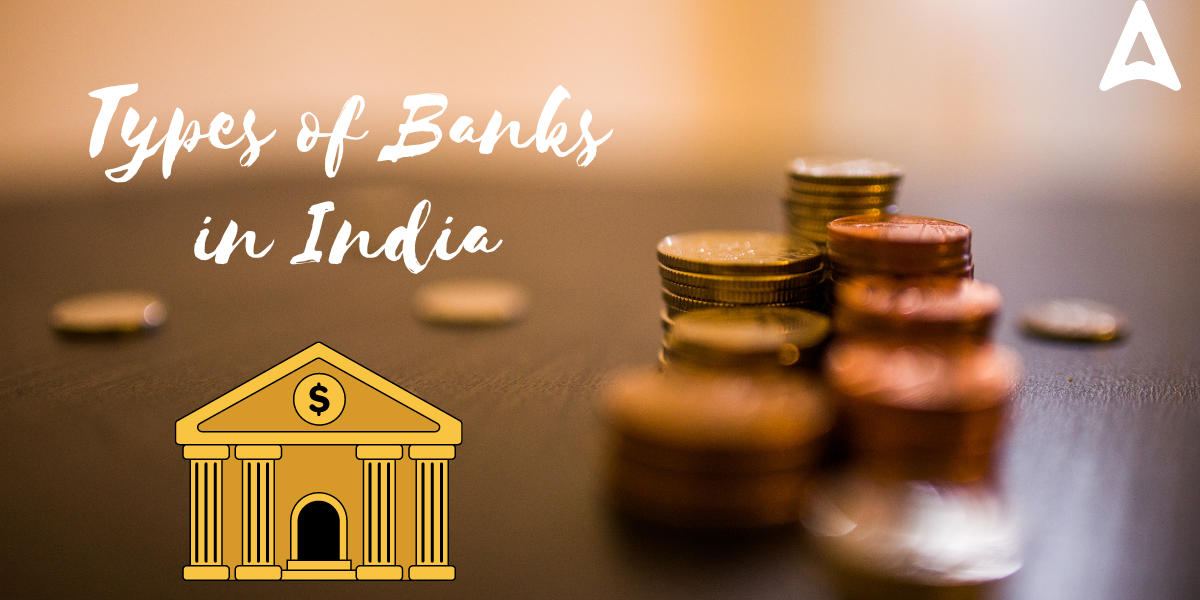Table of Contents
Types of Banks: More or less all of us visit banks for our daily life necessities whether to deposit money or to withdraw money. But Did you know there are different types of Banks to fulfill the different requirements? The banking system is one of the main pillars of any Country’s economy. Like other countries, In India, There are different types of banks are operate for different purposes. So, It is very crucial to know the Types of Banks in India to understand our Economy in a better way. in this article, we will be going to learn How many Types of Banks In India are Operational, their working method, and their Specializations.
Types of Bank
Banks are financial institutional bodies that can receive deposits from individuals and other entities. They also extend credit to entities, all of which contribute significantly to a country’s economic standing. A country’s finances, including cash and credit, are managed by the banking industry. In our country, various types of banks exist to suit the financial needs of diverse groups of individuals involved in agriculture, small Business, Industries, commerce, professions, and so on. Based on their functions, there are different types of banks operating in India as follows:
- Central Bank
- Commercial Banks
- Cooperative Banks
- Regional Rural Banks (RRB)
- Specialized Banks
- Small Finance Banks
- Payments Banks
Types of Banks In India with Examples
There are several distinct types of banks in India, including payment banks, scheduled commercial banks, foreign banks, local banks, and institutions like Reginal Rural Bank, among others. Let’s briefly review the various types of banks in India and their functions.
First Types of Banks- Central Bank
A central bank is an independent agency that is mandated by the government to supervise the nation’s money supply and monetary policy. In India, the Reserve Bank of India has severed as the Our country’s central bank. Each country has a central bank that oversees all other banks in that country. In simple words, Central banks serve as the government’s banks, oversee the monetary policies and system, and provide guidance to other banks and institutions.

Second Types of Banks- Commercial Banks
Commercial banks are governed by the Banking Regulation Act of 1949, and their business style is profit-oriented. They serve all segments, from rural to urban.Their principal duty is to receive deposits and make loans to individuals, businesses, and governments. They have a united structure and are owned by the federal government, state governments, or any private organization. Commercial banks are further subdivided into public-sector banks, private-sector banks, and foreign banks.
Public Sector Banks
Public sector banks are defined as the government or central bank of the nation owns the majority stakes (more than 50%). In India Public sector banks make up more than 75% of the nation’s overall banking industry. Check out the list of the Public sector banks in India below:
- State Bank of India
- Central Bank of India
- Punjab & Sind Bank
- Bank of India
- Punjab National Bank
- Bank of Maharashtra
- Indian Bank
- Bank of Baroda
- Canara Bank
- Union Bank of India
- Indian Overseas Bank
- UCO Bank

Private Sector Banks
Private sector banks are those in which a private organization, an individual, or a group of people owns a significant stake or stock. Aside from the shareholding structure, both public and private sector banks provide the same range of services; nevertheless, all banking rules and regulations imposed by the Reserve Bank of India (the central bank) apply to private sector banks.Some of examples of these types of banks in India are:
- H.D.F.C. Bank
- IDBI Bank
- I.C.I.C.I. Bank
- YES Bank
- Axis Bank
- Kotak Mahindra Bank
- Federal Bank
- IndusInd Bank
Foreign Banks
This type of bank includes private banks with headquarters in foreign nations and branches in our country. These banks must adhere to the regulations of both their home nation and the country in which they operate. Foreign banks that operate in India include:
- Standard Chartered Bank
- Deutsche Bank
- HSBC Bank
- American Express Banking Corporation
- Bank of America
- Citibank
Third Types of Banks- Cooperative Banks
Cooperative banks are governed by an elected managing committee and are recognized under the Cooperative Societies Act of 1912. Cooperative banks’ primary duty is to provide financial resources to the rural people as a whole. In metropolitan regions, cooperative banks primarily serve small enterprises, industries, and self-employment. In rural areas, they mostly fund agricultural industries such as farming, livestock, and hatcheries. These types of banks are future divided into two categories:
a) State Co-operative Banks
b) Urban Co-operative Banks
Forth Types of Bank- Regional Rural Banks (RRB)
Regional rural banks (RRBs) are special commercial banks that offer reduced interest rates on loans to the agricultural and rural sections of the economy. This type of bank was founded to provide loans to the most vulnerable members of society, such as marginal farmers, small companies, and agricultural laborers. After its foundation in 1975, the Regional Rural Bank Act of 1976 formed RRBs. From 1987 through 2005, 196 RRBs were founded.RRBs are 50/50 joint ventures between the federal government (50%), state governments (15%), and commercial banks (35%).
Fifth Types of Banks- Specialized Banks
Specialized banks are founded to serve a certain industry or sector. It may specialize in export and import, or it may offer financial services to specialized businesses. In India, the following types of banks are in operation:
- NABARD (National Bank for Agricultural and Rural Development) – To obtain financial support for rural, handicraft, village, and agricultural development.
- SIDBI (Small Industries Development Bank of India) – This type of bank provides loans for a small-scale company or enterprise.
- EXIM Bank – EXIM Bank is an acronym that stands for Export and Import Bank. To obtain loans or other financial aid from foreign countries when exporting or importing commodities.
Sixth Types of Banks- Small Finance Banks
Small Finance Banks are government-authorized institutions that provide basic banking services to unserved and underserved areas. Small Finance Banks in India aim to bring financial inclusion to less privileged segments of the economy that do not normally have access to banking institutions. Small and micro business units, marginal and small farmers, and diverse entities in the unorganized sector are all served by this type of bank.
Some examples of Small Finance Banks in India are as follows
- ESAF Small Finance Bank Ltd
- AU Small Finance Bank
- Equitas Small Finance Bank
- Jana Small Finance Bank
- Utkarsh Small Finance Bank Ltd
- Northeast Small Finance Bank
- Suryoday Small Finance Bank
- Suryoday Small Finance Bank Ltd
- Ujjivan Small Finance Bank
Seventh Types of Banks- Payments Banks
Payments banks are a recently developed type of banking that was conceptualized by the Reserve Bank of India. Internet banking, mobile banking, and debit card facility are all services provided by payment banks. However, there are several limitations to this form of bank. Payment bank account holders can only deposit up to Rs.1,000,000/- and cannot apply for loans or credit cards with this account. These types of banks in India are listed below:
- Paytm Payments Bank
- Airtel Payments Bank
- Fino Payments Bank
- India Post Payments Bank
- Jio Payments Bank
- NSDL Payments Bank
Types of Banks and Their Functions
The goal of banking systems is to provide economic security and confidence. The operations and functions of banks vary depending on their nature. However, in general, every bank serves two important and primary tasks. A banking system manages the flow of money between individuals and businesses. Banks have their own agency functions in addition to these basic ones. For example, collecting checks, transferring payments, taking custody of assets, and so forth. The following are the functions of a bank:
- Deposits from the general public are accepted.
- Make a demand withdrawal facility available.
- Credit facility
- Transferring funds and providing various sorts of accounts
- Internet banking functions
- Customer service
- Debit and credit cards
- Transfer of funds
- Draft distribution
- Make lockers available to clients.
- Managing Foreign Exchange
How Many Types of Bank Accounts
There are several types of bank accounts that cater to different needs and financial goals. Here are some common types of bank accounts:
Savings Account: A basic account that allows you to deposit and save money while earning a modest interest rate. Savings accounts are generally used for short-term goals and emergency funds.
Checking Account: Also known as a current account, this type of account is designed for everyday transactions. It allows you to write checks, use debit cards, and perform electronic transactions. Checking accounts typically offer lower interest rates compared to savings accounts.
Money Market Account: These accounts usually offer higher interest rates compared to traditional savings accounts. They may have limitations on the number of transactions you can make each month. Money market accounts often require a higher minimum balance.
Certificate of Deposit (CD): CDs are time-bound deposits where you agree to keep your money with the bank for a specific period in exchange for a higher interest rate. If you withdraw the money before the term ends, you may face penalties.
Individual Retirement Account (IRA): IRAs are specialized accounts designed to help individuals save for retirement. There are Traditional IRAs and Roth IRAs, each with different tax advantages and eligibility criteria.
Joint Account: This is an account shared by two or more people, often used by couples, family members, or business partners. All account holders have equal access to the funds.
Business Account: Designed for businesses, these accounts offer features tailored to business needs, such as processing transactions, managing payroll, and accepting payments.
Trust Account: A trust account is managed by a trustee for the benefit of someone else, often used in estate planning or to manage assets on behalf of minors or individuals who can’t manage their finances independently.
Student Account: Banks may offer special accounts for students with features like lower fees and overdraft protection tailored to the needs of students.
Foreign Currency Account: This type of account allows you to hold and transact in foreign currencies, which can be useful for international travelers or those who deal with foreign transactions frequently.
High-Yield Savings Account: Similar to regular savings accounts, but with a higher interest rate. They may require higher minimum balances and can be a good option for people looking for better returns on their savings.
Online Bank Account: These accounts are offered by online-only banks and provide the convenience of managing your finances digitally. They often have lower fees and higher interest rates due to their reduced overhead costs.
HSA (Health Savings Account): A specialized account for individuals with high-deductible health insurance plans. Contributions are tax-deductible, and withdrawals for qualified medical expenses are tax-free.
These are just a few examples of the many types of bank accounts available. The right choice depends on your financial goals, needs, and circumstances. Always compare the features, fees, and benefits of different accounts before making a decision.
10 Types of Banks PDF
Types of bank PDFs are designed by adda247 and is very useful for the aspirants of various exams. Click here to download Types of Banks in India.
| Related posts | |
| Types of Angles | Types of Triangles |
| Types of Motion | Types of Teeth |
| Types of Fever | |



 CUET PG Result 2025 Soon @exams.nta.ac.i...
CUET PG Result 2025 Soon @exams.nta.ac.i...
 NEET Admit Card 2025 Release Date, How t...
NEET Admit Card 2025 Release Date, How t...
 CUET UG 2025 Vs CUET UG 2024, Check Majo...
CUET UG 2025 Vs CUET UG 2024, Check Majo...

